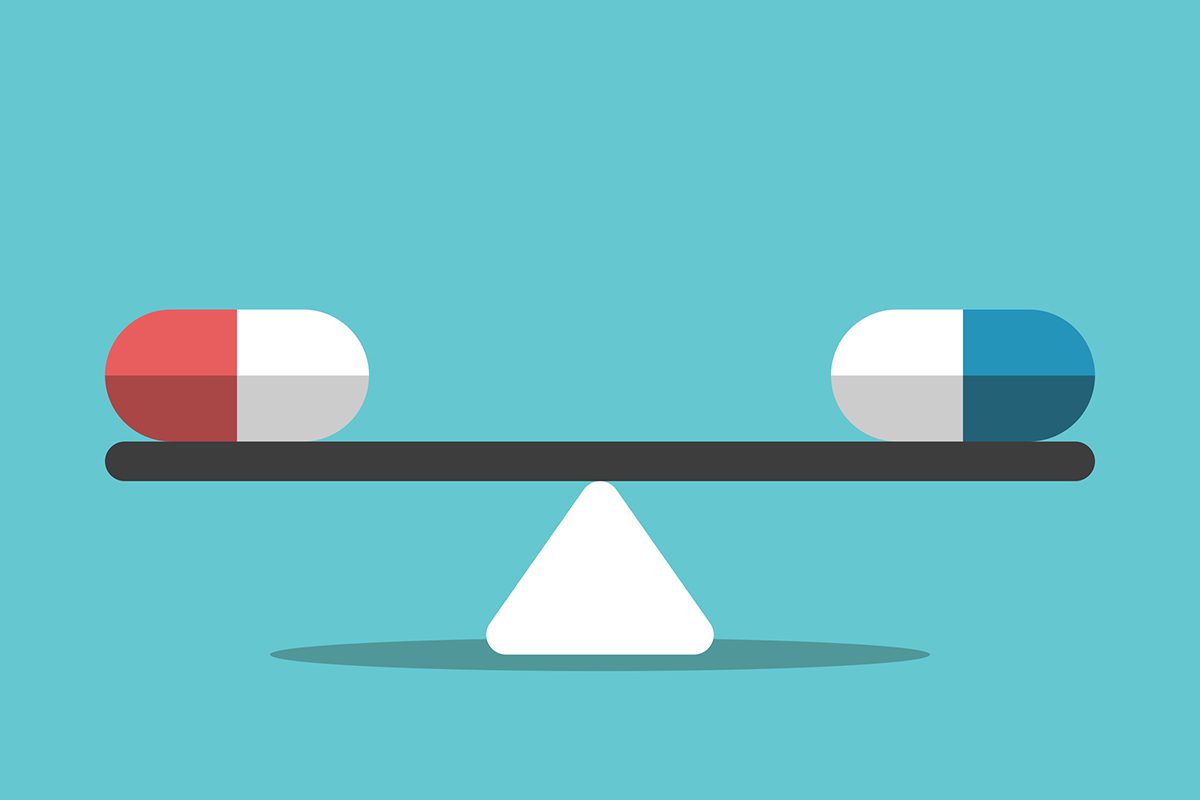Modafinil or armodafinil may be advised for approved or experimental indications in patients diagnosed with schizophrenia. In such situations, clinicians must be aware of the possible pharmacokinetic drug interactions between these drugs and the antipsychotic drugs that the patients may be receiving. Modafinil induces the CYP1A2 and 3A4 enzymes. Armodafinil induces CYP3A4 but not 1A2. Blood levels of antipsychotics metabolized by these enzymes will fall in patients receiving modafinil or armodafinil, and the patients may relapse many months later as a result of diminished antipsychotic efficacy. Because this adverse outcome occurs long after introduction of modafinil or armodafinil, clinicians may fail to recognize that a pharmacokinetic drug interaction was responsible. This article suggests options to avoid or deal with the potential interaction in schizophrenia patients advised to take modafinil or armodafinil.

- Schizophrenia patients may sometimes require modafinil or armodafinil for approved or off-label indications.
- Modafinil and armodafinil induce certain CYP enzymes and thereby reduce levels of antipsychotics that are metabolized by these enzymes.
- The effects of reduced antipsychotic potency associated with the reduced antipsychotic levels may not appear until long after the onset of the pharmacokinetic changes induced by modafinil or armodafinil.
Clinical Problem
Mr P is an obese 52-year-old man with a 20-year history of schizophrenia. He has recently been diagnosed with obstructive sleep apnea and experiences excessive daytime drowsiness as a prominent symptom. His physician wishes to treat him with modafinil or armodafinil to increase alertness during his waking hours. What might be the benefits and risks of such an action?
What Might Be the Positive Spin-Offs Associated With Modafinil or Armodafinil Use in This Patient?
Racemic modafinil and its R-isomer armodafinil are approved treatments for the excessive daytime drowsiness associated with narcolepsy, shift work, and obstructive sleep apnea1; therefore, either of these drugs could benefit Mr P.
In schizophrenia, modafinil and armodafinil have been prescribed, studied, or suggested for off-label indications such as antipsychotic-induced drowsiness,2-4 antipsychotic-related weight gain,5,6 negative symptoms,3,4,7,8 and cognitive impairment.3,4,7,9,10 Favorable results for these off-label indications have mostly been described in anecdotal reports; with a few exceptions, the randomized controlled trials have generally found no advantage for these drugs over placebo.
In summary, modafinil and armodafinil could be expected to improve daytime alertness in Mr P, but, realistically, cognitive and negative symptoms could improve only to the extent that they were worsened specifically by the daytime drowsiness.
What Might Be the Risks Associated With Modafinil or Armodafinil Use in This Patient?
Most antipsychotic drugs are metabolized by the cytochrome P450 (CYP) enzymes 1A2, 2D6, and 3A4. Modafinil induces CYP1A2 and 3A4.11 Armodafinil does not induce CYP1A2 but is a moderate inducer of CYP3A4.12 Thus, modafinil and armodafinil could reduce the blood levels and hence the efficacy of antipsychotics that are metabolized by the induced enzymes.
Antipsychotic substrates of CYP1A2 include olanzapine, clozapine, and asenapine. Antipsychotic substrates of CYP3A4 include quetiapine, ziprasidone, sertindole, iloperidone, aripiprazole, and lurasidone and, to a lesser extent, clozapine, asenapine, and risperidone, as well.13-18 There are few pharmacokinetic data examining specific interactions between modafinil or armodafinil and antipsychotic drugs. As an example, a 5-week study19 found that armodafinil reduced the maximum concentration of quetiapine by 45% and the area under the curve by 42%. However, this reduction was not associated with an increase in positive or negative symptom ratings across 5 weeks of drug use.
Are the Predicted Interactions Likely to Be Clinically Significant?
Yes. For example, armodafinil reduced key pharmacokinetic parameters for quetiapine by 40%-45%19; this is a substantial effect and could be expected to increase the risk of relapse in a stable patient. Nevertheless, in a review of 6 clinical trials, Saavedra-Velez et al3 observed that psychosis exacerbation was recorded in only 5 (6.0%) of 83 patients receiving modafinil relative to 2 (2.9%) of 70 patients receiving placebo; this difference did not reach statistical significance. Also, recent placebo-controlled clinical trials3,4,7-10 of modafinil or armodafinil in schizophrenia did not find an increase in psychopathology associated with active treatment.
What might be the explanation for the apparent lack of risk? There are many possibilities. First, some trials recruited only patients who were receiving olanzapine, risperidone, or paliperidone, that is, antipsychotics that are not (or are minimally) metabolized by the study drug, armodafinil. Next, all trials were short-term studies; for dose reduction to be associated with a detectably increased risk of relapse, a reasonable estimate is that at least 3-6 months of treatment is necessary. Finally, all studies were conducted with small samples; none was adequately powered to identify a significant risk of relapse. Therefore, there is no reassurance to be obtained from the failure of existing trials to identify a risk.
Is There an Important Message Here?
Yes. Clinicians generally expect pharmacokinetic interactions to manifest within days to a few weeks of the introduction of a new drug. Given that many schizophrenia patients may not relapse until several months after antipsychotic discontinuation, chances are that, in an individual patient, it could take several months of lowered antipsychotic levels for psychological decompensation to occur; the risk of such decompensation and the time frame for its occurrence would vary with levels of stress, coping, and social and family support.
Schizophrenia exacerbation resulting from a pharmacokinetic interaction between modafinil (or armodafinil) and an antipsychotic drug such as quetiapine or clozapine may therefore occur after so many months that it might not be recognized as resulting from a drug interaction. Given that schizophrenia is a relapsing disorder, the clinician may believe such relapse to be due to the natural course of the illness rather than to a drug interaction. So, the clinician will not receive the feedback that could correct future practice.
An important message, therefore, is that clinicians should be aware that the effects of a drug interaction may not appear until long after the onset of the pharmacokinetic changes, so initial appearances of safety are no grounds for complacency when combining drugs.
What Are the Treatment Options for This Patient?
Given that the patient requires modafinil or armodafinil, treatment would depend on whether the antipsychotic that the patient is currently receiving is metabolized by CYP1A2 or 3A4 and, if it is a substrate of either or both of these enzymes, whether the clinician prefers to continue the same antipsychotic or switch medications. There are several possibilities:
- Prefer armodafinil over modafinil. Armodafinil does not induce CYP1A212 and can be prescribed to patients who receive 1A2 substrates such as olanzapine.
- Switch to an antipsychotic drug that is not metabolized or minimally metabolized by the liver, such as paliperidone, sulpiride, levosulpiride, and amisulpride.20
- Switch to an antipsychotic drug that is metabolized through pathways that do not appreciably involve CYP1A2 and 3A4. These drugs include risperidone14 and, to the extent that the topic has been studied, many of the first-generation antipsychotics, as well.21
- Raise the dose of the current antipsychotic drug, if it is a substrate of CYP1A2 or 3A4. The difficulty lies in knowing how high to raise the dose. If facilities for therapeutic drug level monitoring are available, the dose could be increased until active moiety (parent antipsychotic and active metabolite) levels approximate those that antedated the introduction of modafinil or armodafinil. Otherwise, the clinician would need to be guided by a mixture of judgment, prudence, and luck, bounded by the patient’s tolerance of the higher dose.
J Clin Psychiatry 2012;73(8):e1062-e1064 (doi:10.4088/JCP.12f07977)
© Copyright 2012 Physicians Postgraduate Press, Inc.
 Each month in his online column, Dr Andrade considers theoretical and practical ideas in clinical psychopharmacology with a view to update the knowledge and skills of medical practitioners who treat patients with psychiatric conditions.
Each month in his online column, Dr Andrade considers theoretical and practical ideas in clinical psychopharmacology with a view to update the knowledge and skills of medical practitioners who treat patients with psychiatric conditions.
Department of Clinical Psychopharmacology and Neurotoxicology, National Institute of Mental Health and Neurosciences, Bangalore, India ([email protected]).
Financial disclosure and more about Dr Andrade.
References
1. Garnock-Jones KP, Dhillon S, Scott LJ. Armodafinil. CNS Drugs. 2009;23(9):793-803. PubMed doi:10.2165/11203290-000000000-00000
2. Makela EH, Miller K, Cutlip WD 2nd. Three case reports of modafinil use in treating sedation induced by antipsychotic medications. J Clin Psychiatry. 2003;64(4):485-486. PubMed doi:10.4088/JCP.v64n0420h
3. Saavedra-Velez C, Yusim A, Anbarasan D, et al. Modafinil as an adjunctive treatment of sedation, negative symptoms, and cognition in schizophrenia: a critical review. J Clin Psychiatry. 2009;70(1):104-112. PubMed doi:10.4088/JCP.07r03982
4. Freudenreich O, Henderson DC, Macklin EA, et al. Modafinil for clozapine-treated schizophrenia patients: a double-blind, placebo-controlled pilot trial. J Clin Psychiatry. 2009;70(12):1674-1680. PubMed doi:10.4088/JCP.08m04683
5. Roerig JL, Steffen KJ, Mitchell JE, et al. An exploration of the effect of modafinil on olanzapine associated weight gain in normal human subjects. Biol Psychiatry. 2009;65(7):607-613. PubMed doi:10.1016/j.biopsych.2008.10.037
6. Henderson DC, Freudenreich O, Borba CP, et al. Effects of modafinil on weight, glucose and lipid metabolism in clozapine-treated patients with schizophrenia. Schizophr Res. 2011;130(1-3):53-56. PubMed doi:10.1016/j.schres.2011.04.009
7. Kane JM, D’ Souza DC, Patkar AA, et al. Armodafinil as adjunctive therapy in adults with cognitive deficits associated with schizophrenia: a 4-week, double-blind, placebo-controlled study. J Clin Psychiatry. 2010;71(11):1475-1481. PubMed doi:10.4088/JCP.09m05950gry
8. Arbabi M, Bagheri M, Rezaei F, et al. A placebo-controlled study of the modafinil added to risperidone in chronic schizophrenia. Psychopharmacology (Berl). 2012;220(3):591-598. PubMed doi:10.1007/s00213-011-2513-z
9. Bobo WV, Woodward ND, Sim MY, et al. The effect of adjunctive armodafinil on cognitive performance and psychopathology in antipsychotic-treated patients with schizophrenia/schizoaffective disorder: a randomized, double-blind, placebo-controlled trial. Schizophr Res. 2011;130(1-3):106-113. PubMed doi:10.1016/j.schres.2011.05.015
10. Scoriels L, Barnett JH, Soma PK, et al. Effects of modafinil on cognitive functions in first episode psychosis. Psychopharmacology (Berl). 2012;220(2):249-258. PubMed doi:10.1007/s00213-011-2472-4
11. Robertson P Jr, Hellriegel ET. Clinical pharmacokinetic profile of modafinil. Clin Pharmacokinet. 2003;42(2):123-137. PubMed doi:10.2165/00003088-200342020-00002
12. Darwish M, Kirby M, Robertson P Jr, et al. Interaction profile of armodafinil with medications metabolized by cytochrome P450 enzymes 1A2, 3A4 and 2C19 in healthy subjects. Clin Pharmacokinet. 2008;47(1):61-74. PubMed doi:10.2165/00003088-200847010-00006
13. Spina E, de Leon J. Metabolic drug interactions with newer antipsychotics: a comparative review. Basic Clin Pharmacol Toxicol. 2007;100(1):4-22. PubMed doi:10.1111/j.1742-7843.2007.00017.x
14. Sheehan JJ, Sliwa JK, Amatniek JC, et al. Atypical antipsychotic metabolism and excretion. Curr Drug Metab. 2010;11(6):516-525. PubMed doi:10.2174/138920010791636202
15. Marino J, Caballero J. Iloperidone for the treatment of schizophrenia. Ann Pharmacother. 2010;44(5):863-870. PubMed doi:10.1345/aph.1M603
16. Caccia S. Pharmacokinetics and metabolism update for some recent antipsychotics. Expert Opin Drug Metab Toxicol. 2011;7(7):829-846. PubMed doi:10.1517/17425255.2011.575061
17. Citrome L. Lurasidone for schizophrenia: a brief review of a new second-generation antipsychotic. Clin Schizophr Relat Psychoses. 2011;4(4):251-257. PubMed doi:10.3371/CSRP.4.4.5
18. Chwieduk CM, Scott LJ. Asenapine: a review of its use in the management of mania in adults with bipolar I disorder. CNS Drugs. 2011;25(3):251-267. PubMed doi:10.2165/11206700-000000000-00000
19. Darwish M, Bond M, Hellriegel ET, et al. Investigation of a possible interaction between quetiapine and armodafinil in patients with schizophrenia: an open-label, multiple-dose study [published online ahead of print September 8, 2011]. J Clin Pharmacol. PubMed
20. Andrade C. Schizophrenia and smoking. J Clin Psychiatry. 2012;73(6):e725-e727. PubMed
21. P450 drug interaction table. Division of Clinical Pharmacology, Department of Medicine, Indiana University School of Medicine Web site. http://medicine.iupui.edu/clinpharm/ddis/table.aspx. Accessed June 22, 2012.
This PDF is free for all visitors!





